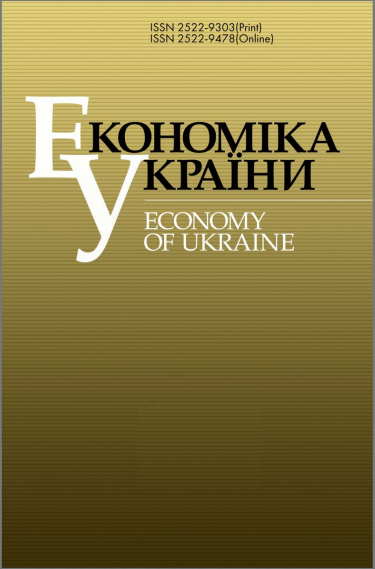Положення про рецензування
Основна мета процесу рецензування полягає в підвищенні наукової цінності статей, які публікуються в журналі, шляхом формування об’єктивних процедур відбору авторських рукописів і визначення зважених підходів до розроблення рекомендацій щодо їх поліпшення.
Усі статті, надіслані до журналу, якщо вони відповідають його профілю і підготовлені згідно із стандартами й Вимогами журналу, передаються на рецензування не менш як трьом рецензентам.
Як рецензенти залучаються сторонні висококваліфіковані фахівці, які володіють глибокими знаннями за певним науковим напрямом і/або мають необхідний досвід роботи в певній сфері економіки, наукові публікації з відповідної проблематики, а – в разі необхідності – члени Редакційної колегії. Рецензії, які автори надсилають самостійно, редакцією не розглядаються.
Рецензенти проводять критичне й об'єктивне оцінювання наданих для рецензування авторських рукописів, дотримуючись вимог Комітету з етики в публікаціях, який розробив Рекомендації для рецензентів щодо дотримання етичних принципів та стандартів . Обов’язок рецензентів – об’єктивно визначити переваги і недоліки статті, її науковий рівень, бережно ставитися до викладених у ній нових наукових знань, докладати зусиль, щоб не постраждала репутація і кар’єра автора.
Кожна стаття проходить «сліпе» подвійне рецензування – експертам не розголошуються прізвища авторів та їхні персональні дані, а авторам не повідомляються прізвища рецензентів. Рецензенти визнають, що відправлені їм рукописи є інтелектуальною власністю авторів, отже, розміщені в них наукові здобутки та інші відомості не підлягають розголошенню.
Рецензенти надсилають свої рецензії на електронну пошту журналу або надають через електронний кабінет на вебресурсі у встановлені терміни у двох варіантах – з підписом рецензента (у форматі PDF) і без зазначення його прізвища (у форматі word), який надсилається автору статті. Усі підписані рецензії зберігаються протягом трьох років від дня їх отримання. Відповідальною особою за їх зберігання є заступник головного редактора або відповідальний секретар. Після завершення цього терміну вони знищуються відповідно до Порядку поводження з документами, які підлягають утилізації.
Членам редколегії для ознайомлення розсилаються повні тексти статей, які виносяться на розгляд засідання Редколегії.
Стосовно кожної статті, що виноситься на розгляд Редколегії, колегіально може бути ухвалено одне з таких рішень: «Друкувати»; «Друкувати з урахуванням зауважень»; «На доопрацювання і візування (конкретним членом редколегії/рецензентом)» «На доопрацювання з повторним винесенням на розгляд редколегії»; «Відхилити». Стаття може бути відхилена у випадках невідповідності профілю журналу, низького наукового рівня, виявлення плагіату. В разі відхилення статті Редакційна колегія не веде з автором перемовин і дискусій.
Термін, відведений на рецензування, становить 14–30 днів.
Про ухвалене Редакційною колегією рішення щодо статті автору повідомляють листом електронною поштою за підписом заступника головного редактора (відповідального секретаря). Автор зобов’язаний максимально врахувати наведені в рецензіях пропозиції і зауваження, крім випадку, коли щодо статті ухвалене рішення «Відхилити».
Доопрацьовану статтю автор надсилає на офіційну електронну пошту або надає через електронний кабінет на вебресурсі. Статтю повторно переглядає Головний редактор (заступники головного редактора) на предмет повноти й якості врахування зауважень рецензентів і відповідності оформлення статті вимогам Видання.
У разі належного доопрацювання і оформлення рукопис, згідно з попереднім рішенням щодо нього Редакційної колегії, може завізувати до друку відповідний член Редакційної колегії, рецензент, або Головний редактор (заступник головного редактора), або вона може бути винесена на повторний розгляд Редакційної колегії.
У разі повторного розгляду Редакційною колегією стаття або рекомендується до друку, або відхиляється без можливості її подальшого доопрацювання.
У випадку виявлення факту плагіату і/або самоплагіату в надмірному (25–30%) обсязі в уже опублікованій статті Головний редактор, рецензент, член Редакційної колегії повідомляє про це всіх інших членів Редколегії, яка своїм рішенням відкликає статтю. Повідомлення про відкликання розміщується в електронній версії на сторінці відповідної статті й у черговому після виявлення факту порушення академічної доброчесності друкованому номері журналу. В повідомленні має бути зазначена причина відкликання й особа, яка ініціювала відкликання. Стаття на вебресурсі зберігається без змін, за винятком водяного знака «відкликано» на кожній сторінці в PDF-файлі. Щодо автора, який порушив принципи академічної доброчесності, Редакційна колегія ухвалює рішення про відмову розглядати будь-які його статті протягом двох років.


